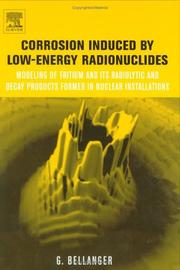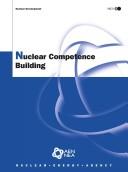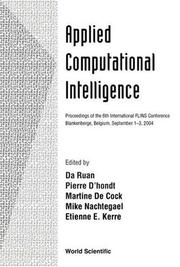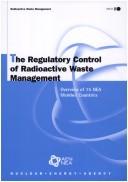| Listing 1 - 10 of 27 | << page >> |
Sort by
|
Book
Year: 2004 Publisher: Washington, DC : Spent Fuel Project Office, Office of Nuclear Material Safety and Safeguards, U.S. Nuclear Regulatory Commission,
Abstract | Keywords | Export | Availability | Bookmark
 Loading...
Loading...Choose an application
- Reference Manager
- EndNote
- RefWorks (Direct export to RefWorks)
Nuclear fuels --- Criticality (Nuclear engineering) --- Storage --- Safety measures.
Book
ISBN: 9782868836724 2868836720 Year: 2004 Publisher: Les Ulis : EDP sciences,
Abstract | Keywords | Export | Availability | Bookmark
 Loading...
Loading...Choose an application
- Reference Manager
- EndNote
- RefWorks (Direct export to RefWorks)
Nuclear engineering --- Nuclear facilities --- Génie nucléaire --- Installations nucléaires --- Monograph

ISBN: 1280171707 9786610171705 9264016724 9789264016729 9264016716 Year: 2004 Publisher: Paris : OECD Publishing,
Abstract | Keywords | Export | Availability | Bookmark
 Loading...
Loading...Choose an application
- Reference Manager
- EndNote
- RefWorks (Direct export to RefWorks)
As modern nuclear power programmes mature and large, commercial nuclear power plants and fuel cycle facilities approach the end of their useful life by reason of age, economics or change of policy on the use of nuclear power, new challenges associated with decommissioning and dismantling come to the fore. Politicians and the public may expect there to be a “right answer” to the choice of strategy for a particular type of facility, or even all facilities. Both this seminar and wider experience show that this is not the case. Local factors and national political positions have a significant input and often result in widely differing strategy approaches to broadly similar decommissioning projects. All facility owners represented at the seminar were able to demonstrate a rational process for strategy selection and compelling arguments for the choices made. In addition to the papers that were presented, these proceedings include a summary of the discussions that took place.
Nuclear facilities. --- Nuclear facilities --- Nuclear Engineering --- Mechanical Engineering --- Engineering & Applied Sciences --- Decommissioning --- Atomic facilities --- Facilities, Nuclear --- Nuclear installations --- Nuclear energy --- Nuclear engineering --- Spain --- Installations nucléaires --- Congresses. --- Déclassement --- Congrès

ISBN: 1281056677 9786611056674 0080530036 0080445101 9780080445106 9780080530031 Year: 2004 Publisher: Amsterdam : Elsevier,
Abstract | Keywords | Export | Availability | Bookmark
 Loading...
Loading...Choose an application
- Reference Manager
- EndNote
- RefWorks (Direct export to RefWorks)
Nuclear power plants emit radiation and particles across a range of energies. This radiation can cause corrosion to occur in critically important parts of the plant, which can lead to efficiency and safety problems. Gamma rays and neutrons have the highest energies and can break the metal bonds in interior metallic structures causing damage quickly and in easily monitored ways. Consequently these types of radiation and the best alloys to use to mitigate their effects have been extensively researched and their findings applied. However, the same is not true of low energy radiation which
Tritium. --- Metals --- Nuclear engineering --- Corrosion fatigue. --- Safety measures. --- Corrosion fatigue of metals --- Corrosion and anti-corrosives --- Hydrogen --- Fatigue --- Isotopes

ISBN: 128017272X 9786610172726 9264108513 9789264108516 9264108505 Year: 2004 Publisher: Paris : OECD Publishing,
Abstract | Keywords | Export | Availability | Bookmark
 Loading...
Loading...Choose an application
- Reference Manager
- EndNote
- RefWorks (Direct export to RefWorks)
At a time when government R&D funding for nuclear energy has been dramatically reduced and profit margins of electricity generators have been squeezed, this report presents the result of an international survey on recent initiatives in the area of nuclear education and training. It dicusses key human resource issues and good practice for international collaboration, which are seen as ameliorating the decline of technical innovation and competence in the nuclear sector. The report includes an executive summary along with conclusions and recommendations aimed at policy makers and other stakeholders. It also contains in-depth analysis of the factual information collected.
Nuclear engineering. --- Nuclear engineering --- Nuclear energy --- Nuclear Engineering --- Mechanical Engineering --- Engineering & Applied Sciences --- Study and teaching (Higher) --- In-service training --- Government policy --- Research --- Atomic energy --- Atomic power --- Energy, Atomic --- Energy, Nuclear --- Nuclear power --- Power, Atomic --- Power, Nuclear --- Atomic power engineering --- Force and energy --- Nuclear physics --- Power resources --- Nuclear facilities --- Nuclear power plants --- Engineering

ISBN: 9812388737 9786611372859 1281372854 9812702660 9789812702661 9789812388735 9781281372857 Year: 2004 Publisher: Singapore Hong Kong World Scientific
Abstract | Keywords | Export | Availability | Bookmark
 Loading...
Loading...Choose an application
- Reference Manager
- EndNote
- RefWorks (Direct export to RefWorks)
FLINS, originally an acronym for "Fuzzy Logic and Intelligent technologies in Nuclear Science", has now been extended to include computational intelligent systems for applied research. FLINS 2004, is the sixth in a series of international conferences, covers state-of-the-art research and development in applied computational intelligence for applied research in general and for power/nuclear engineering in particular. This book presents the latest research trends and future research directions in the field. The proceedings have been selected for coverage in:. Index to Scientific & Technical Pr
Computational intelligence. --- Computational intelligence --- Fuzzy logic --- Nuclear engineering --- Engineering & Applied Sciences --- Computer Science --- Mathematics --- Atomic power engineering --- Engineering --- Nuclear physics --- Nuclear energy --- E-books --- Monograph
Book
ISBN: 9264020608 Year: 2004 Volume: 5491 Publisher: Paris : OCDE,
Abstract | Keywords | Export | Availability | Bookmark
 Loading...
Loading...Choose an application
- Reference Manager
- EndNote
- RefWorks (Direct export to RefWorks)
Nuclear engineering --- Nuclear facilities --- Nuclear energy --- Génie nucléaire --- Installations nucléaires --- Energie nucléaire --- Safety measures --- Safety measures --- Sécurité --- Mesures --- Mesures de sécurité
Book
Year: 2004 Publisher: Paris : OECD Publishing,
Abstract | Keywords | Export | Availability | Bookmark
 Loading...
Loading...Choose an application
- Reference Manager
- EndNote
- RefWorks (Direct export to RefWorks)
The S&T Statistical Compendium 2004 was prepared for the January 2004 meeting of the Committee for Scientific and Technological Policy (CSTP) at Ministerial level and mainly draws on databases, indicators and methodology developed by the CSTP’s Working Party of National Experts on Science and Technology Indicators (NESTI) Working Party, and compiled by the Directorate for Science, Technology and Industry (DSTI). It presents a wide selection of the most policy-relevant and internationally comparable indicators currently available in the field of science and technology. The document looks at the state of science and technology in the OECD across four broad dimensions:• Section A: Innovation and R&D.• Section B: Human Resources in Science and Technology (HRST).• Section C: Patents.• Section D: Other areas (ICT, globalisation, industrial structure).
Science and Technology --- Industry and Services --- Nuclear reactors --- Nuclear power plants --- Nuclear Engineering --- Mechanical Engineering --- Engineering & Applied Sciences --- Congresses --- Measurement --- Congresses --- Instruments
Book
Year: 2004 Publisher: Paris : OECD Publishing,
Abstract | Keywords | Export | Availability | Bookmark
 Loading...
Loading...Choose an application
- Reference Manager
- EndNote
- RefWorks (Direct export to RefWorks)
The S&T Statistical Compendium 2004 was prepared for the January 2004 meeting of the Committee for Scientific and Technological Policy (CSTP) at Ministerial level and mainly draws on databases, indicators and methodology developed by the CSTP’s Working Party of National Experts on Science and Technology Indicators (NESTI) Working Party, and compiled by the Directorate for Science, Technology and Industry (DSTI). It presents a wide selection of the most policy-relevant and internationally comparable indicators currently available in the field of science and technology. The document looks at the state of science and technology in the OECD across four broad dimensions:• Section A: Innovation and R&D.• Section B: Human Resources in Science and Technology (HRST).• Section C: Patents.• Section D: Other areas (ICT, globalisation, industrial structure).
Science and Technology --- Industry and Services --- Nuclear reactors --- Nuclear power plants --- Nuclear Engineering --- Mechanical Engineering --- Engineering & Applied Sciences --- Congresses --- Measurement --- Congresses --- Instruments

ISBN: 1280172428 9786610172429 9264106529 9789264106529 9264106502 Year: 2004 Publisher: Paris : OECD Publishing,
Abstract | Keywords | Export | Availability | Bookmark
 Loading...
Loading...Choose an application
- Reference Manager
- EndNote
- RefWorks (Direct export to RefWorks)
Regulators are major stakeholders in the decision-making process for radioactive waste management. The NEA Radioactive Waste Management Committee (RWMC) has recognised the value of exchanging and comparing information about national regulatory practices and having an informal, international network for discussing issues of common concern. The RWMC Regulators’ Forum provides considerable opportunity for such activities. This report presents the initial results of the Forum’s work. Information is given for 15 NEA member countries in a format that allows easy accessibility to specific aspects and comparison between different countries. It includes an array of facts about national policies for radioactive waste management, institutional frameworks, legislative and regulatory frameworks, available guidance, classification and sources of waste and the status of waste management. It also provides an overview of current issues being addressed and related R&D programmes.
Radioactive wastes. --- Radioactive wastes --- Radioactive waste disposal --- Environmental Engineering --- Civil & Environmental Engineering --- Engineering & Applied Sciences --- Management --- Nuclear waste disposal --- Nuclear engineering --- Radioactivity --- Refuse and refuse disposal --- Radioactive pollution --- Safety measures --- Management.
| Listing 1 - 10 of 27 | << page >> |
Sort by
|

 Search
Search Feedback
Feedback About UniCat
About UniCat  Help
Help News
News